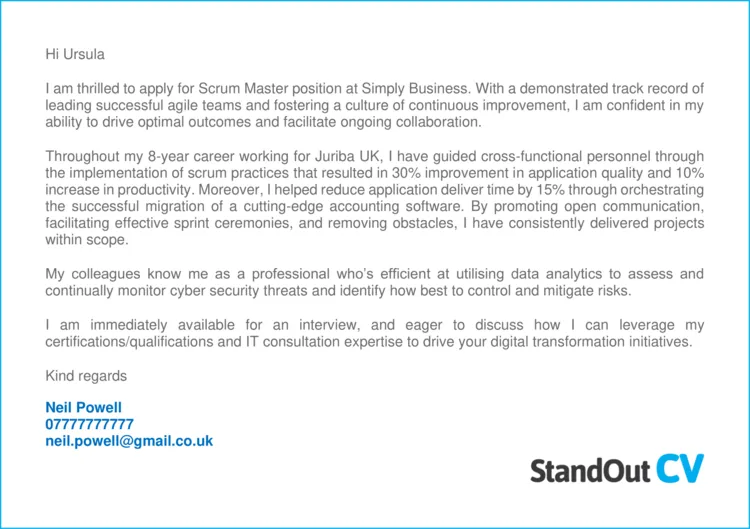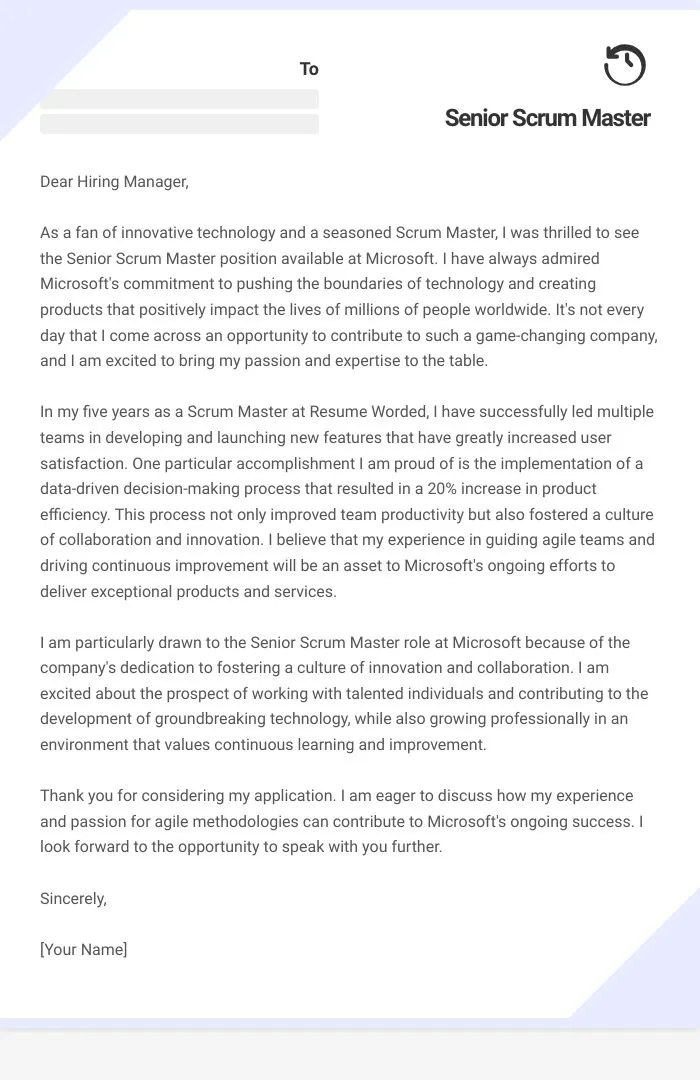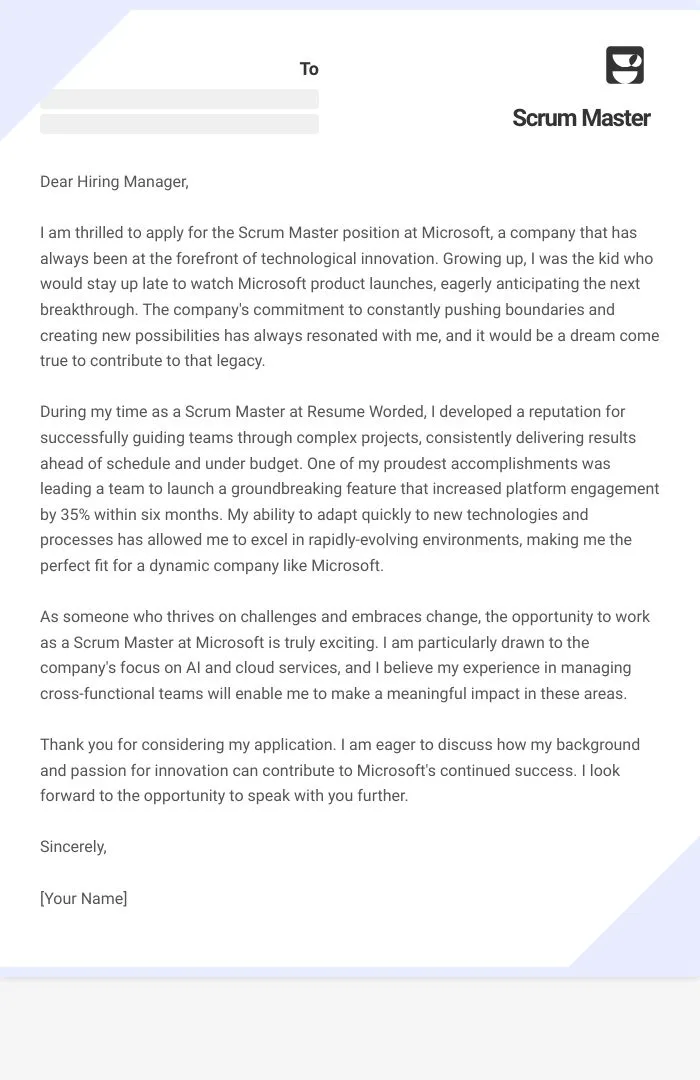Crafting a compelling Scrum Master cover letter can significantly increase your chances of landing your dream job. A well-written cover letter is your opportunity to showcase your skills, experience, and passion for Agile methodologies. It’s a crucial document that allows you to make a strong first impression and differentiate yourself from other candidates. This guide provides the top five tips for writing an impactful Scrum Master cover letter that highlights your expertise and helps you stand out to potential employers. By following these tips, you’ll be well-equipped to create a cover letter that gets you noticed and moves you closer to your career goals.
Highlighting Your Scrum Master Skills
Your cover letter should immediately showcase your core Scrum Master skills. This includes your proficiency in facilitating Scrum ceremonies, removing impediments, coaching the team, and promoting Agile principles. Avoid generic statements; instead, use specific examples. For instance, instead of saying ‘I have experience with daily stand-ups,’ describe how you’ve improved stand-up meetings to enhance team collaboration and information sharing. Mention your experience with sprint planning, sprint reviews, and sprint retrospectives, highlighting how you’ve helped teams achieve their sprint goals. Make it clear you understand the Scrum framework and can apply it effectively to drive project success. Provide concrete examples of how you have guided teams towards self-organization and high performance. Focus on how you’ve empowered teams to embrace Agile values and principles.
Demonstrating Agile Project Expertise
A successful Scrum Master cover letter should clearly illustrate your expertise in Agile project management. This involves detailing your experience with Agile methodologies, such as Scrum, Kanban, or XP. Explain how you’ve implemented Agile practices within different projects and teams. Discuss specific Agile tools and techniques you’ve used, such as sprint backlogs, burndown charts, and user stories. Detail your familiarity with Agile frameworks and principles, and how you have applied these to drive project success. Emphasize your ability to facilitate Agile ceremonies effectively, such as sprint planning, daily stand-ups, sprint reviews, and retrospectives. Show how you have helped teams to adapt to change, embrace feedback, and continuously improve their processes. Highlight your ability to drive innovation and foster a culture of continuous improvement.
Quantifying Achievements in Cover Letter

Whenever possible, quantify your achievements with data and metrics. Instead of saying ‘I improved team performance,’ state ‘I increased team velocity by 20% within three months by implementing X technique.’ Provide specific examples of how your actions as a Scrum Master have led to positive outcomes. Highlight any cost savings, time efficiencies, or quality improvements you’ve achieved. For instance, if you’ve helped a team reduce defects, mention the percentage reduction. If you’ve improved the speed of product delivery, include the time saved. Use numbers to demonstrate your impact and make your accomplishments more credible. This approach not only showcases your skills but also proves your ability to deliver tangible results in previous roles. Use data-driven insights to support your claims and present a compelling narrative of your success.
Tailoring to the Specific Job
Customize your cover letter for each job application. Generic cover letters often get overlooked. Review the job description carefully and identify the key requirements and desired skills. Then, tailor your cover letter to match those requirements. Highlight the experiences and skills that are most relevant to the specific role. Use the same keywords and phrases that are used in the job description. Show how your experience and skills align with the specific needs of the company and the project. Avoid sending a generic letter and personalize it to show your genuine interest and suitability for the position. This targeted approach demonstrates that you’ve taken the time to understand the role and are genuinely interested in joining the company. Make sure to address specific aspects mentioned in the job description.
Researching the Company Culture
Before writing your cover letter, research the company’s culture, values, and projects. Demonstrate your understanding of their specific needs and goals. Visit the company website, read their blog, and check their social media profiles to gather insights. Use this information to tailor your cover letter and show how you align with their values. If the company emphasizes innovation, mention your experience with innovative Agile practices. If they prioritize collaboration, highlight your skills in team building and communication. Show how your experience and skills align with the company’s culture and values. This demonstrates that you’ve done your homework and are genuinely interested in joining the organization. This level of preparation will make a strong impression and set you apart from other candidates.
Showcasing Scrum Master Certifications

List all your relevant certifications, such as Certified ScrumMaster (CSM), Professional Scrum Master (PSM), or Advanced Certified ScrumMaster (ACSM). Mention the certifying organization and the date you earned your certification. Certifications demonstrate your commitment to Agile practices and provide employers with confidence in your expertise. Place your certifications prominently in your cover letter to catch the recruiter’s attention. If you have multiple certifications, prioritize the ones most relevant to the job description. Including your certifications, especially those recognized by the industry, shows your dedication to continuous learning and professional development. These credentials are a strong indicator of your knowledge and expertise in the field of Scrum and Agile methodologies.
Emphasizing Communication and Leadership
Highlight your communication and leadership skills. Scrum Masters must be excellent communicators, facilitators, and leaders. Showcase your ability to communicate effectively with both technical and non-technical team members. Mention your experience in leading and mentoring Agile teams. Provide examples of how you’ve motivated teams, resolved conflicts, and fostered a collaborative environment. Demonstrate your ability to adapt your communication style to different audiences. Mention how you have built strong relationships with stakeholders, including product owners, development teams, and management. Show your ability to lead by example and inspire others to embrace Agile principles. These skills are essential for the role of a Scrum Master.
Demonstrating Active Listening and Collaboration
Emphasize your active listening and collaboration skills. Scrum Masters need to listen attentively to team members, understand their concerns, and facilitate effective communication. Provide examples of how you’ve resolved conflicts, fostered collaboration, and built consensus within a team. Mention how you’ve encouraged open communication, and provided feedback to team members. Highlight how you’ve used your listening skills to identify and address impediments, create a positive team environment. Demonstrating the ability to actively listen and collaborate is key to fostering team success and achieving project goals. Illustrate examples in which you have mediated between different perspectives to achieve a common ground and positive outcome.
Highlighting Conflict Resolution

Scrum Masters are often called upon to resolve conflicts within the team. Show your experience in mediating disagreements, and finding solutions that benefit the entire team. Describe your approach to conflict resolution and the strategies you employ to address issues effectively. Highlight your ability to remain neutral, actively listen to different perspectives, and facilitate discussions that lead to positive outcomes. Mention specific instances where you successfully resolved conflicts and fostered a more collaborative and productive environment. Include examples of how you’ve guided the team toward finding mutually acceptable solutions, fostering open communication, and maintaining a positive work atmosphere.
Proofreading and Formatting
Proofread your cover letter carefully for any grammatical errors or typos. A well-formatted and error-free cover letter demonstrates professionalism and attention to detail. Ask a friend or colleague to review your cover letter to catch any mistakes you may have missed. Ensure that the formatting is consistent and easy to read. Use clear and concise language and avoid jargon or overly technical terms. Proofreading is a critical step; a single error can negatively impact your application. Take the time to review the document multiple times, and use grammar and spell-check tools. Ensure your cover letter is polished and professional to create a positive first impression.
Ensuring Error-Free Document
Pay close attention to grammar and spelling throughout your cover letter. Errors can undermine your credibility and professionalism. Use a grammar checker and spell checker to catch any obvious mistakes. However, do not rely solely on these tools, as they may not catch all errors. Read your cover letter aloud to ensure that the text flows smoothly and makes sense. Proofread multiple times, looking for inconsistencies and awkward phrasing. A clean, error-free cover letter shows that you pay attention to detail and can communicate effectively. A well-crafted cover letter demonstrates your professionalism and attention to detail, key qualities for a Scrum Master.
Formatting for Readability

Format your cover letter for easy readability. Use a clean and professional font, such as Arial or Times New Roman, with a font size between 10 and 12 points. Use clear headings, subheadings, and bullet points to organize your content. Ensure that there is enough white space to make the letter visually appealing. Keep paragraphs concise and to the point. Avoid dense blocks of text. Make your cover letter easy to scan and read. Use formatting to emphasize key skills and accomplishments. A well-formatted letter makes it easier for recruiters to quickly grasp the key information and assess your qualifications. This is a crucial step in ensuring your cover letter is effective.
By following these tips, you can create a compelling Scrum Master cover letter that showcases your skills, experience, and passion for Agile methodologies. Remember to tailor your letter to each job, quantify your achievements, and highlight your key skills. Good luck with your job search!
